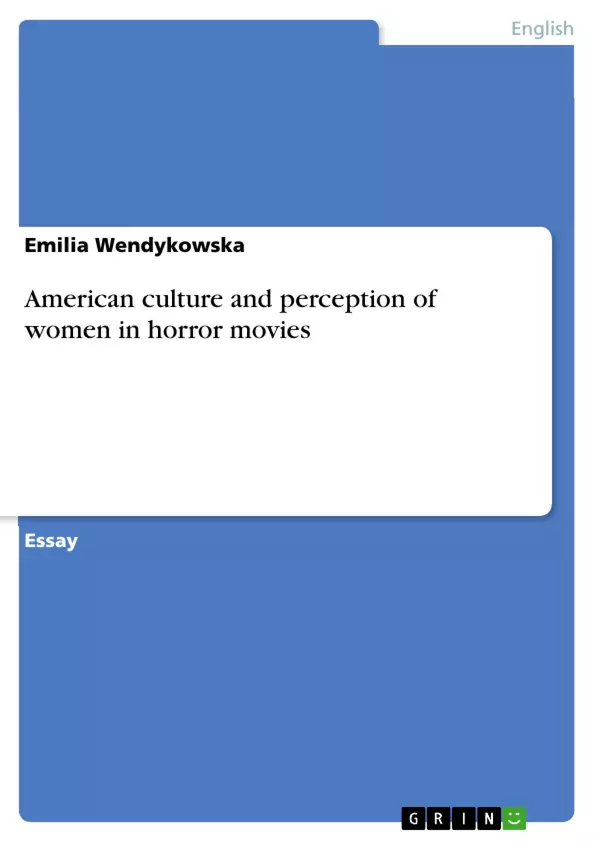Horror genre has its origins in the gothic 19th century novels like Marry Shelley’s Frankenstein (1818) or John Polidori’s The Vampire (1819). Even though horror movie is a typical European genre, it has a long history in American cinema dating back to 1915 silent movie Les Vampires by Freuillade and to one of the first sound movies from 1931, Tod Browning’s famous Dracula. Horror movies may be put into three categories: ones that contain the supernatural elements, in which vampires, ghosts, witchcraft appears; psychological horror, which relies on characters’ fears, their guilt or beliefs; and massacre movies, with scenes of slaughter, brutality and rough treatment (Cinema Studies 184).
Although horror movies, as an element of mass culture, may be perceived as simplistic, predictable, lacking depth and simply being an unworthy for analysis, there is a great deal of films that in its content reflect the contemporary problems that occurred in the American society. While many critics consider horror genre as a “low culture,” one must not fail to notice that its significance is enormous. One can sense an inextricable link between film and social concerns, since the role of the film is to project certain fears and concerns of contemporary society as well as to help people to resolve them. As Prawer observed: "If the terror film is thus connected to our social concerns, it also, paradoxically, helps us to cope with our ordinary life by jolting us out of it" (60). A popular opinion has it that the popularity of horror movies increases along with the disturbance experienced by the society. Since the 20th century is perceived as the era of the constant social upheaval, the history of the horror movie equals the history of the anxiety (Wells 3); hence, the time the cultural chaos erupts, the audience turns to horror movies as a means that liberates them from their anxiety. As Phillips asserts, “anxiety tends to promote a sense of helplessness; fear, on the other hand, provides an impetus for change” (9). Thus, the fear evoked by the slasher film, one is forced to invent new ways of coping with his or her difficulties, since a typical way of thinking will occur not only problematic but also troublesome.
Inhaltsverzeichnis (Table of Contents)
- The Projection of Changes in American Culture and the Perception of Women in Contemporary Horror Movies
- Psycho (1960) by Alfred Hitchcock
- The Social Unrest of the 1950s
- The Role of Money and Consumption
- Changing Gender Roles
- Halloween (1978) by John Carpenter
- The Social Unrest of the 1970s
- The Rise of the Slasher Genre
Zielsetzung und Themenschwerpunkte (Objectives and Key Themes)
This text explores the ways in which contemporary horror movies reflect and project changes in American culture, particularly focusing on the perception of women. The study examines the anxieties and social unrest prevalent in the 1950s and 1970s through the lenses of Alfred Hitchcock's "Psycho" and John Carpenter's "Halloween," respectively.
- The relationship between horror movies and social anxieties
- The influence of cultural shifts on horror film themes and imagery
- The representation of gender roles and sexual dynamics in horror movies
- The use of horror films as a means to explore and address societal fears
- The evolution of the slasher genre and its reflection of cultural anxieties
Zusammenfassung der Kapitel (Chapter Summaries)
The text begins by examining the origins and significance of the horror genre, highlighting its ability to reflect and engage with contemporary social concerns. It then delves into a detailed analysis of Hitchcock's "Psycho" as a representation of the social unrest and cultural shifts of the 1950s. The chapter explores how the film's themes of consumerism, changing gender roles, and societal anxieties are manifested in the characters and plot.
The next section focuses on John Carpenter's "Halloween" as a reflection of the social unrest and cultural transformations of the 1970s. The chapter analyzes the emergence of the slasher genre, its key elements, and its connection to the hedonistic and sexually liberated culture of the time. The text examines how "Halloween" reflects the anxieties surrounding sexual freedom and the changing perception of gender roles.
Schlüsselwörter (Keywords)
The text primarily focuses on the themes of horror movies, American culture, gender roles, social anxieties, consumerism, and the slasher genre. Key examples are used, such as "Psycho," "Halloween," and the "Final Girl" archetype. These concepts are examined through the lens of their historical context and their impact on the development and representation of the horror genre.
- Citation du texte
- Emilia Wendykowska (Auteur), 2012, American culture and perception of women in horror movies, Munich, GRIN Verlag, https://www.grin.com/document/196807



